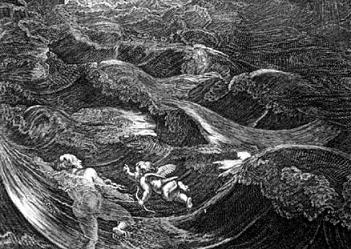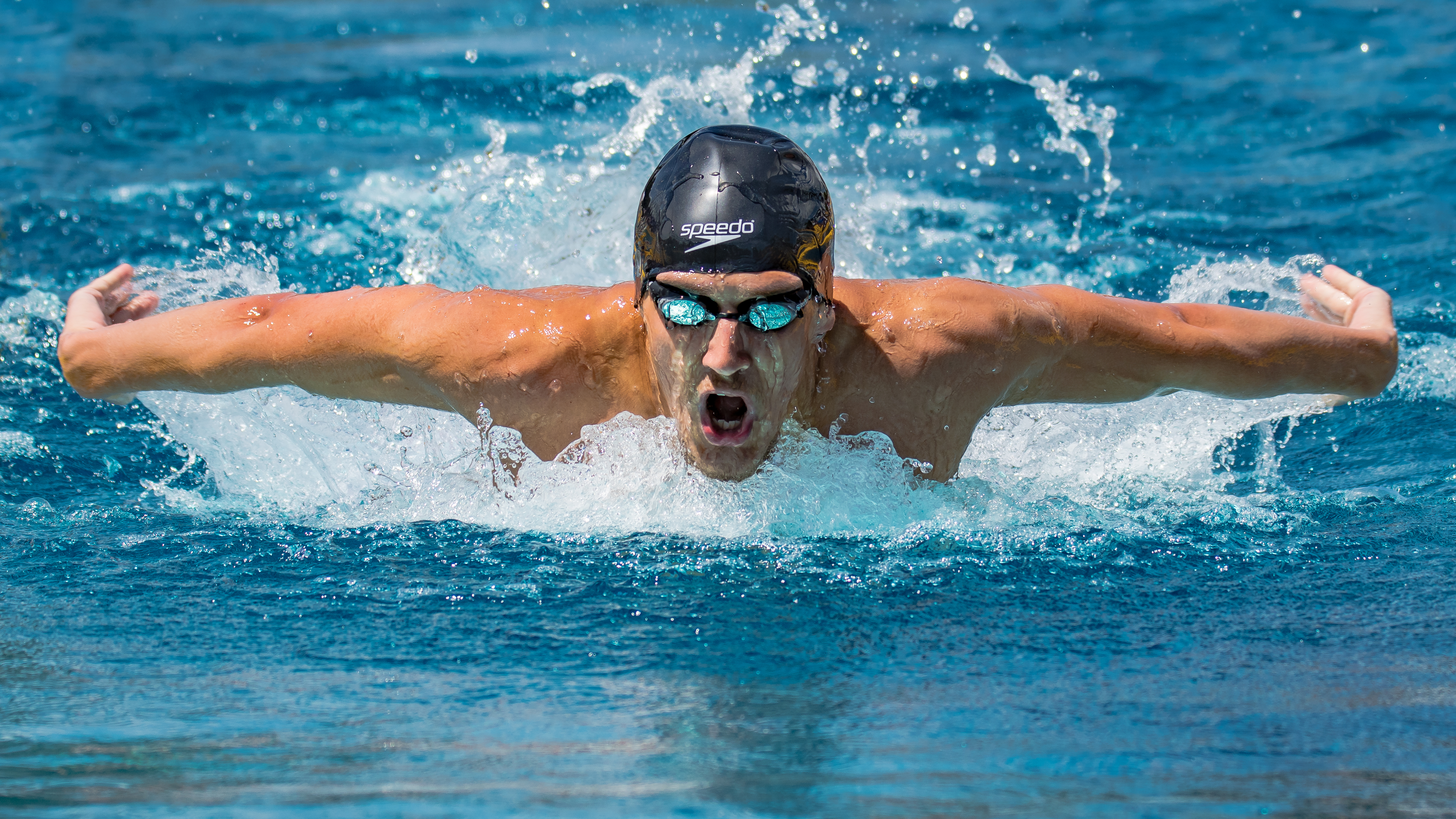|
Breaststroke
Breaststroke is a swimming style in which the swimmer is on their chest and the torso does not rotate. It is the most popular recreational style due to the swimmer's head being out of the water a large portion of the time, and that it can be swum comfortably at slow speeds. In most swimming classes, beginners learn either the breaststroke or the freestyle (front crawl) first. However, at the competitive level, swimming breaststroke at speed requires endurance and strength comparable to other strokes. Some people refer to breaststroke as the "frog" stroke, as the arms and legs move somewhat like a frog swimming in the water. The stroke itself is the slowest of any competitive strokes and is thought to be the oldest of all swimming strokes. Speed and ergonomics Breaststroke is the slowest of the four official styles in competitive swimming. The fastest breaststrokers can swim about 1.70 meters (~5.6 feet) per second. It is sometimes the hardest to teach to rising swimmers ... [...More Info...] [...Related Items...] OR: [Wikipedia] [Google] [Baidu] |
Swimming (sport)
Swimming is an individual or team racing sport that requires the use of one's entire body to move through water. The sport takes place in pools or open water (e.g., in a sea or lake). Competitive swimming is one of the most popular Olympic sports, with varied distance events in butterfly, backstroke, breaststroke, freestyle, and individual medley. In addition to these individual events, four swimmers can take part in either a freestyle or medley relay. A medley relay consists of four swimmers who will each swim a different stroke, ordered as backstroke, breaststroke, butterfly and freestyle. Swimming each stroke requires a set of specific techniques; in competition, there are distinct regulations concerning the acceptable form for each individual stroke. There are also regulations on what types of swimsuits, caps, jewelry and injury tape that are allowed at competitions. Although it is possible for competitive swimmers to incur several injuries from the sport, such as ... [...More Info...] [...Related Items...] OR: [Wikipedia] [Google] [Baidu] |
Butterfly (swimming)
The butterfly (colloquially shortened to fly) is a swimming stroke swum on the chest, with both arms moving symmetrically, accompanied by the butterfly kick (also known as the " dolphin kick"). While other styles like the breaststroke, front crawl, or backstroke can be swum adequately by beginners, the butterfly is a more difficult stroke that requires good technique as well as strong muscles. It is the newest swimming style swum in competition, first swum in 1933 and originating out of the breaststroke. Speed and ergonomics The peak speed of the butterfly is faster than that of the front crawl due to the synchronous pull/push with both arms and legs, which is done quickly. Yet since speed drops significantly during the recovery phase, it is overall slightly slower than front crawl, especially over longer distances. Another reason it is slower is because of the extremely different physical exertion it puts on the swimmer compared to the front crawl. Butterfly stroke witho ... [...More Info...] [...Related Items...] OR: [Wikipedia] [Google] [Baidu] |
Butterfly Stroke
The butterfly (colloquially shortened to fly) is a swimming stroke swum on the chest, with both arms moving symmetrically, accompanied by the butterfly kick (also known as the "dolphin kick"). While other styles like the breaststroke, front crawl, or backstroke can be swum adequately by beginners, the butterfly is a more difficult stroke that requires good technique as well as strong muscles. It is the newest swimming style swum in competition, first swum in 1933 and originating out of the breaststroke. Speed and ergonomics The peak speed of the butterfly is faster than that of the front crawl due to the synchronous pull/push with both arms and legs, which is done quickly. Yet since speed drops significantly during the recovery phase, it is overall slightly slower than front crawl, especially over longer distances. Another reason it is slower is because of the extremely different physical exertion it puts on the swimmer compared to the front crawl. Butterfly stroke without ... [...More Info...] [...Related Items...] OR: [Wikipedia] [Google] [Baidu] |
Masaru Furukawa
was a Japanese swimmer and Olympic champion. He competed at the 1956 Olympic Games in Melbourne, where he received a gold medal in the 200 m breaststroke."1956 Olympics – Melbourne, Australia – Swimming" – ''databaseOlympics.com'' (Retrieved on September 5, 2008) World records Furukawa improved the world record of 200 metres breaststroke (long course) four times in 1954 and 1955, and his last record lasted until 1958.Awards Furukawa was inducted into the |
Human Swimming
Swimming is the self-propulsion of a person through water, or other liquid, usually for recreation, sport, exercise, or survival. Locomotion is achieved through coordinated movement of the limbs and the body to achieve hydrodynamic thrust that results in directional motion. Humans can hold their breath underwater and undertake rudimentary locomotive swimming within weeks of birth, as a survival response. Swimming is consistently among the top public recreational activities, and in some countries, swimming lessons are a compulsory part of the educational curriculum. As a formalized sport, swimming is featured in a range of local, national, and international competitions, including every modern Summer Olympics. Swimming involves repeated motions known as strokes in order to propel the body forward. While the front crawl, also known as freestyle, is widely regarded as the fastest out of four primary strokes, other strokes are practiced for special purposes, such as for trainin ... [...More Info...] [...Related Items...] OR: [Wikipedia] [Google] [Baidu] |
Front Crawl
The front crawl or forward crawl, also known as the Australian crawl or American crawl, is a swimming stroke usually regarded as the fastest of the four front primary strokes. As such, the front crawl stroke is almost universally used during a freestyle swimming competition, and hence freestyle is used metonymically for the front crawl. It is one of two long axis strokes, the other one being the backstroke. Unlike the backstroke, the butterfly stroke, and the breaststroke, the front crawl is not regulated by the FINA. This style is sometimes referred to as the Australian crawl although this can sometimes refer to a more specific variant of front crawl. Ergonomics The face-down swimming position allows for a good range of motion of the arm in the water, as compared to the ''backstroke'', where the hands cannot be moved easily along the back of the spine. The above-water recovery of the stroke reduces drag, compared to the underwater recovery of ''breaststroke''. The alternating ... [...More Info...] [...Related Items...] OR: [Wikipedia] [Google] [Baidu] |
Frog Kick
Finning techniques are the skills and methods used by swimmers and underwater divers to propel themselves through the water and to maneuver when wearing swimfins. There are several styles used for propulsion, some of which are more suited to particular swimfin configurations. There are also techniques for positional maneuvering, such as rotation on the spot, which may not involve significant locational change. Use of the most appropriate finning style for the circumstances can increase propulsive efficiency, reduce fatigue, improve precision of maneuvering and control of the diver's position in the water, and thereby increase the task effectiveness of the diver and reduce the impact on the environment. Propulsion through water requires much more work than through air due to higher density and viscosity. Diving equipment which is bulky usually increases drag, and reduction of drag can significantly reduce the effort of finning. This can be done to some extent by streamlining divi ... [...More Info...] [...Related Items...] OR: [Wikipedia] [Google] [Baidu] |
David Armbruster (swim Coach)
Jack Sieg was an American swimmer who used the butterfly stroke in 1935, developed by his coach David (aka Dave) Armbruster. He competed for the University of Iowa and first used the stroke in a breaststroke leg of a medley relay February 25, 1935. February 26, 1935: “for the first time in competition Monday” (). See also *History of swimming
Swimming was part of the first modern Olympic games in 1896 in Athens. ...
[...More Info...] [...Related Items...] OR: [Wikipedia] [Google] [Baidu] |
Jack Sieg
Jack Sieg was an American swimmer who used the butterfly stroke in 1935, developed by his coach David (aka Dave) Armbruster. He competed for the University of Iowa and first used the stroke in a breaststroke leg of a medley relay Medley or Medleys may refer to: Sports *Medley swimming, races requiring multiple swimming styles *Relay race#Medley relay, Medley relay races at track meets Music *Medley (music), multiple pieces strung together People *Medley (surname), list ... February 25, 1935. February 26, 1935: “for the first time in competition Monday” ( The Milwaukee Journal). See also *[...More Info...] [...Related Items...] OR: [Wikipedia] [Google] [Baidu] |
Matthew Webb
Captain Matthew Webb (19 January 1848 – 24 July 1883) was an English swimmer and stuntman. He is the first recorded person to swim the English Channel for sport without the use of artificial aids. In 1875, Webb swam from Dover to Calais in less than 22 hours. This made him a celebrity, and he performed many stunts in public. He died trying to swim the Whirlpool Rapids below Niagara Falls, a feat declared impossible. Early life and career Webb was born in High Street, Dawley (now part of Telford), in Shropshire, one of fourteen children of a surgeon. Matthew Webb, and his wife Sarah Cartwright Webb, who moved with the family to Madeley High Street in 1849, and then by 1856 to Eastfield House, Coalbrookdale. He acquired his ability to swim in the River Severn at Coalbrookdale. In 1860, at the age of twelve, he joined the training ship HMS ''Conway'' for two years, then entered the merchant navy and served an apprenticeship with Rathbone Brothers of Liverpool.Article on Mat ... [...More Info...] [...Related Items...] OR: [Wikipedia] [Google] [Baidu] |
Melchisédech Thévenot
Melchisédech (or Melchisédec) Thévenot (c. 1620 – 29 October 1692) was a French author, scientist, traveler, cartographer, orientalist, inventor, and diplomat. He was the inventor of the spirit level and is also famous for his popular posthumously published 1696 book ''The Art of Swimming'', one of the first books on the subject and widely read during the 18th century (Benjamin Franklin, an avid swimmer in his youth, is known to have read it). The book popularized the breaststroke (see History of swimming) ; he was inducted into the International Swimming Hall of Fame in 1990. He also influenced the founding of the Académie Royale des Sciences (the French Academy of Sciences). Life Thévenot came from a family of royal office holders (nobles of the robe), which partly explains his wealth. He was reputed to speak English, Greek, Latin, Hebrew, and several oriental languages, including Arabic and Turkish. Thévenot's baptismal name was Nicolas, Melchisédech being added as t ... [...More Info...] [...Related Items...] OR: [Wikipedia] [Google] [Baidu] |
Streamline (swimming)
Streamline form is a swimming technique that is used underwater in every stroke. At the start of a race or on a turn, streamline form is used, usually along with a dolphin kick or flutter kick, to create the least amount of resistance to help the swimmer propel as far as they can. Many factors contribute to the perfect streamline form and mastering this method increases a swimmer's speed. Streamline is one of the key fundamentals to mastering any stroke. Technique The streamline position consists of a person placing hand over hand, fingers over fingers and raising their arms above their head so the biceps are tucked close to the ears. The belly is sucked back to decrease curvature of the spine in the lower back and the swimmer's head is brought back to ensure that neck is in line with the spine Pinching the shoulder blades together is helpful in aligning the spine to straighten out the back. Legs are straight and feet are pointed. In theory, a perfect, straight line will be made d ... [...More Info...] [...Related Items...] OR: [Wikipedia] [Google] [Baidu] |





.jpg)
